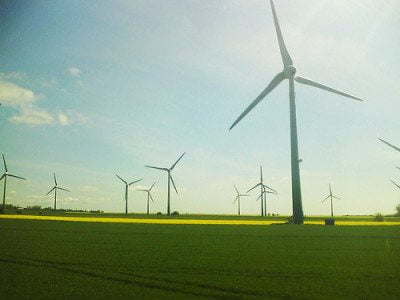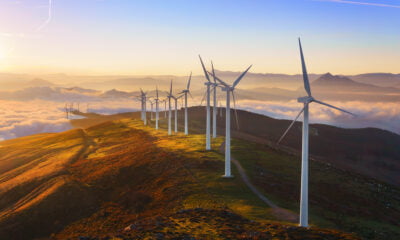

Energy
Investing In Clean Energy – The Low Risk Way
This article first appeared on 3D Investing’s blog and is republished with kind permission. John Fleetwood writes: “Clean energy has been one of the darlings of the sustainable investment world, at least in terms of investor demand. Its something that every socially motivated investor wants to have in their portfolio, but until relatively recently, it has proven an almost unmitigated disaster area for investors.”
It may be that clean energy investment will prove to be highly profitable over the decades ahead, but the last decade has not been encouraging and this sort of volatility does not sit well in most people’s portfolios. So are there any alternatives and if so, are they worthy of consideration? I believe there are, and I’d like to highlight two ways of investing in renewable energy without being exposed to the volatility of clean energy equities.The first is via environmental infrastructure funds.
These are a relatively recent phenomenon in the UK, and consist of large portfolios of renewable energy assets, often already operational and with long-term, relatively secure contracts for the energy they produce. This removes much of the risk of planning and development, albeit with lower potential returns. Typically, these funds are structured as investment trusts with a target initial yield of around 6% that is expected to grow in line with inflation.
Borrowings are secured for periods similar to the expected lifetime of energy generation, and income is underpinned by long term agreements, often in association with Government incentives. All of this makes infrastructure funds a less risky way of investing in clean energy, albeit without the potential upside offered by renewable energy equities. That said, an inflation linked dividend of 6% isn’t to be sneezed at, especially when there is the potential for modest capital growth on top of that.
I suspect that many, if not most investors, would rather accept a lower overall return than take on a high level of volatility.Most of the funds trade at a modest discount to their net asset value, and are either wholly focused on one form of clean energy (wind or solar), or a combination. The table below summarises those available in the UK. All of these funds are now paying dividends of 5.5% or more, supported by predictable revenue streams from operational assets.
There are also a number of funds that invest in environmental assets, of which a large proportion is invested in renewable energy. The other way of investing in clean energy that I’d like to highlight is community share issues. These are promoted as social investments as indeed they are, but they also offer long term income streams that might be considered to be less volatile than investing directly in listed companies.
There have been a proliferation of such investments over the past few years, boosted by Government tax incentives. These took some of the risk our of investment by providing generous tax relief up front and with the maturation of the industry, the Government now considers that this is no longer appropriate. Although disappointing, the withdrawal of tax relief is testament to the predictable nature of the income streams and the lowered risk of this type of investment.
The number of new solar investments has diminished sharply but there are still opportunities for both solar and wind investments in community based projects. There are two very good community investment sites that facilitate investment in these type of projects.The first is Ethex, a partner of 3D Investing. Ethex makes positive investing easy to understand and do, providing a direct and personal way for individuals to invest in businesses they believe in. It does this by providing in depth social and financial profiles that enable comparison of the investments. Investment can then be made online in a simple and straightforward way. Current offers include:
A 3 year bond paying 6% interest to finance new solar energy projects in the Bristol area.
A 2 year bond paying 5.5% interest to purchase the assets of a solar Community Interest Company.
Shares in a Community Benefit Society with a forecast return of 6-8%, derived from investing in two community owned wind turbines.
The second portal for community energy investment is Abundance. Abundance is wholly focused on community energy investment and offers peer-to-peer investments in long term debentures. Most notably, Abundance has pioneered a pretty unique financing model, whereby the majority of investments offer the repayment of capital and interest every six months throughout the term of the investment. So far, £1,241,437 has been paid back to investors by way of capital repayments and interest on £14,771,983 capital raised, offering proof of the business model.
Furthermore, it provides a secondary market in investments with £178,511 having been traded already. This is very encouraging as these types of investment having historically proven to be very illiquid with poorly functioning secondary markets. Abundance has also enabled investment through a pension. This is to be lauded as these investments generate long term income flows that match the required profile of an investor seeking income in retirement, or for whom the long term predictability of returns is highly desirable. The usual financial caveats apply, but this is a very significant development. Well done, Abundance.


 Environment10 months ago
Environment10 months agoAre Polymer Banknotes: an Eco-Friendly Trend or a Groundswell?

 Environment11 months ago
Environment11 months agoEco-Friendly Home Improvements: Top 7 Upgrades for 2025

 Features9 months ago
Features9 months agoEco-Friendly Cryptocurrencies: Sustainable Investment Choices

 Features10 months ago
Features10 months agoEco-Friendly Crypto Traders Must Find the Right Exchange




























